Social media posts are a source of hot and valuable information. While the majority of people use social media to discuss cats, dogs, celebrities, and their kids, there are also posts that call for violence, discuss cybersecurity attacks, and announce breaking news. But discovering such posts — or anomalies — manually in an ever-growing pile of content is nearly impossible.
Organizations that aim to improve public safety can ensure timely discovery of and response to unusual posts if they use a solution combining media monitoring and anomaly detection capabilities. In this article, we discuss key components for building such a solution with the help of artificial intelligence (AI) algorithms and Python tools.
This article will be useful for project managers, AI teams, and SaaS development teams that plan on developing an anomaly detection solution for social media.
Contents:
- Why detect anomalies on social media, and how can AI help?
- Who can benefit from a social media anomaly detection solution?
- Which SaaS features are important for anomaly detection?
- How to apply AI for detecting anomalies on social media
- What are the challenges of building a SaaS-based anomaly detection solution?
- Conclusion
Why detect anomalies on social media, and how can AI help?
In IT systems, an anomaly is an event or a data record that deviates from expectations. In the context of social media, anomaly detection helps analyze events, trends, or personalities and catch meaningful changes in the behavior of individuals as well as groups of people. Non-typical user behavior, hot new topics, and hate speech can be considered anomalies.
Previously, this type of work was done manually. For example, police officers could monitor local groups on social networks to detect threats, and journalists could look on social media for new stories and discussion topics.
Now, AI-powered technologies enable organizations to automate those activities. Using machine learning (ML) and artificial intelligence algorithms to detect anomalies is more efficient for several reasons:
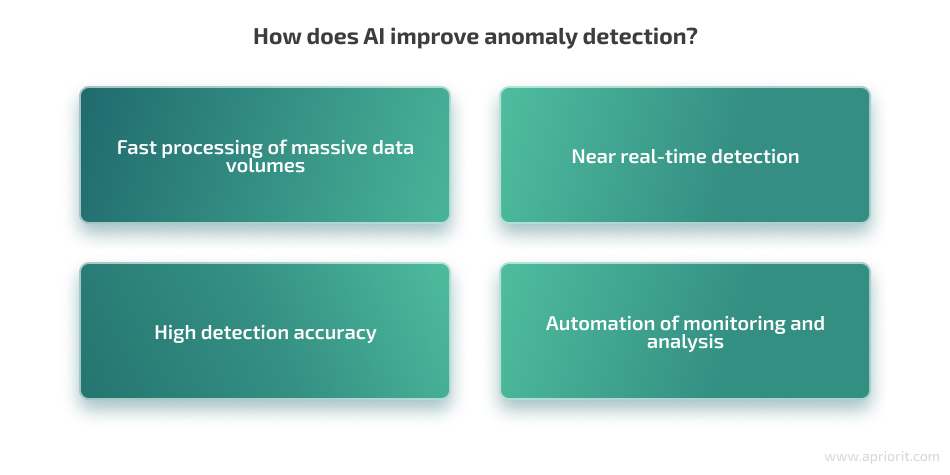
Despite these benefits, AI-based anomaly detection cannot replace specialists that analyze anomalies and make decisions based on this analysis. Such solutions can only save time on data collection and preliminary analysis.
Who can benefit from a social media anomaly detection solution?
Social networks are no longer places only for conversations with friends. People use them to conduct business, read and break news, and even plan events and activities. That’s why a wide range of organizations need to monitor social networks for different types of anomalies.
AI-based anomaly detection on social media can be useful for organizations that operate in various industries:
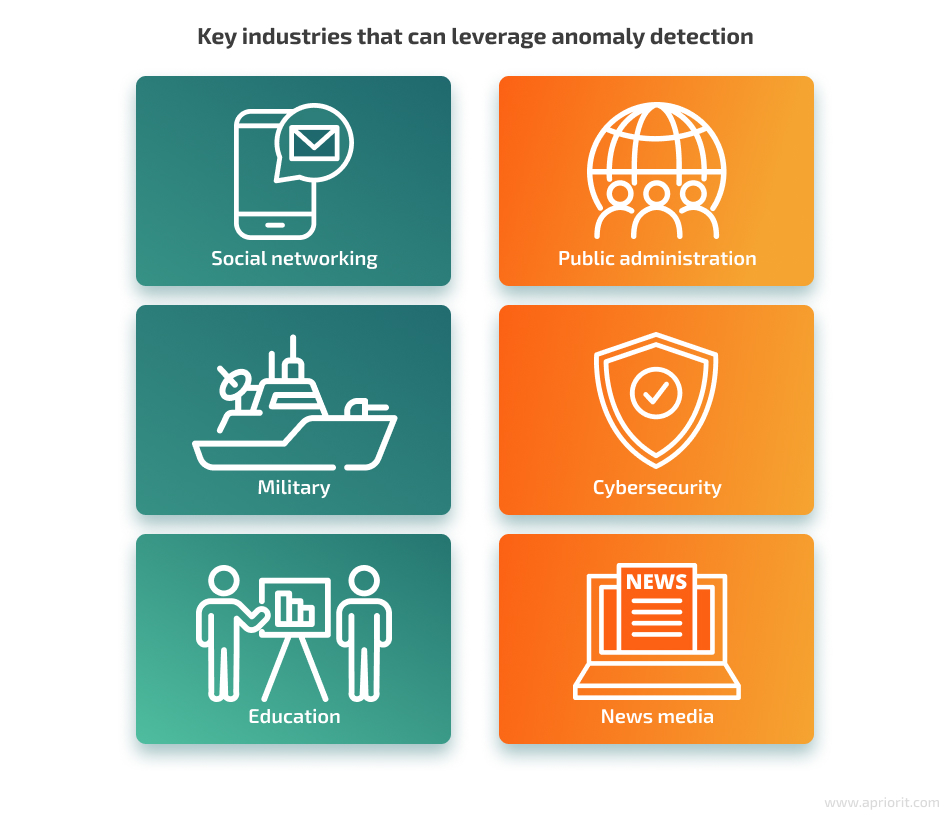
Social networking. Any social network has to be able to detect and stop events like hate speech, fake news, impersonation, and bot attacks. Social network developers can rely on support employees and reports from users to detect such threats, but that requires lots of time and money. Instead, they can implement AI-based anomaly detection to ensure a comfortable environment for their users.
Public administration. Preventing threats to people is one of the key goals of any government. Monitoring texts and videos on social media allows government organizations to detect violations of public order, physical abuse, threats to national security, and other types of potentially illegal activity. It’s especially useful for uncovering events that happen out of the public eye, such as domestic violence and illegal deals.
Military. National and international military organizations monitor social media to detect potential military threats and gather intelligence. Anomalies on social media are also important for open-source intelligence (OSINT) operations, as they may indicate information leaks, hidden user profiles, unannounced military operations, and so on.
Cybersecurity. For cybersecurity specialists, anomalies in security-related social media can be a sign of potentially malicious activity. They can reveal preparations for hacking attempts, insider attacks, data leaks, etc. Such data helps to prevent security threats and improve the overall cybersecurity posture of organizations.
Education. Physical safety of students is an ever-growing concern for educational organizations. With social media monitoring and anomaly detection, schools and universities can always be aware of the discussions inside their campuses and possible threats from outside.
News media. Monitoring posts on social media is a large part of any journalist’s routine. Journalists look for news, expert opinions, and new trends, which are all anomalies from the data analysis standpoint. Applying a dedicated anomaly detection solution for this task saves a lot of time for employees of news media organizations and allows them to break news faster.
Such a wide range of use cases means there can’t be a one-size-fits-all social media anomaly detection solution. You can use a variety of development approaches and tools to build a solution that fits your exact needs. At Apriorit, we have experience working on cloud-based anomaly detection using Python and AI, so in this article, we’ll focus on this technology stack.
Python provides developers with lots of tools for AI development and a wide range of integration options. This language has several packages and numerous libraries dedicated to AI development. Using them allows you to greatly reduce development time because, in most cases, you don’t need to invent your own solution. And in cases when you do, you can get help from detailed Python documentation and a strong community.
Deploying an anomaly detection solution in the cloud allows you to benefit from all the SaaS advantages: 24/7 availability, access from any location and device with an internet connection, cost-efficient resource use, and more. Access to cloud hardware is also handy if you consider the GPU shortage that may be caused by booming AI development.
Let’s take a look at key non-AI features that can help you detect anomalies on social media.
Enhance your software with advanced text processing!
Get a solution fitted to your business needs and requirements by leveraging rich Apriorit’s experience in AI technologies.
Which SaaS features are important for anomaly detection?
Let’s take a close look at the core features to pay attention to when designing an anomaly detection system:
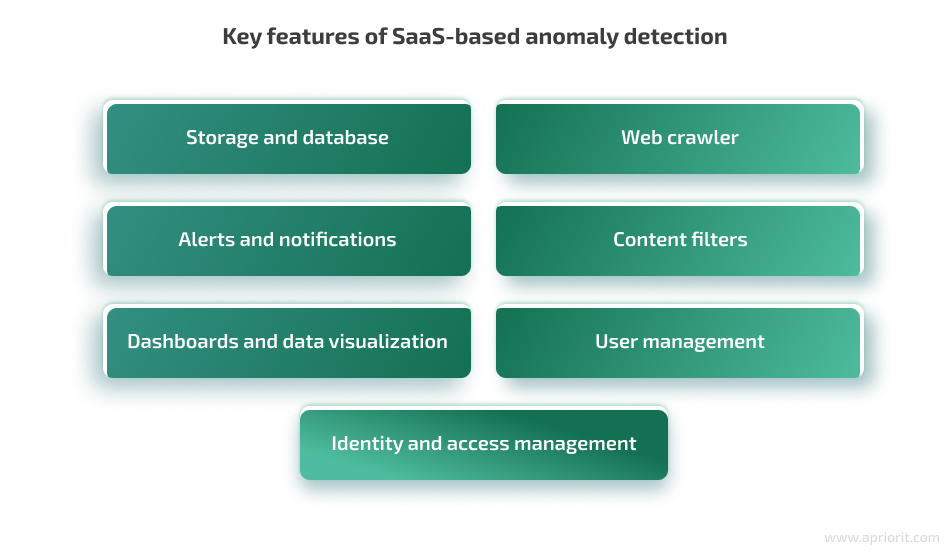
Storage and databases. An anomaly detection solution collects, processes, and generates a lot of data. You can store this data using a cloud service like Amazon S3 or Google Cloud Storage. For a database, consider using Apache Cassandra or MongoDB, as both efficiently manage large amounts of general-purpose data and work fast under a heavy load.
Web crawler. This part of the solution has to search social media and download data for the AI to analyze. You can configure the types of data the crawler downloads. Depending on your project’s needs and requirements, you can use open-source frameworks like Scrapy to implement a web crawler or develop custom functionality. Python provides Request and Beautiful Soup libraries that you can use for this task.
Alerts and notifications. One of the key advantages of using the cloud and AI for anomaly detection is near real-time flagging of unusual content. To help users quickly analyze and respond to anomalies, you can implement alerts in the form of desktop messages, emails, and messenger notifications. Common communication tools like Gmail, Slack, and Telegram provide APIs you can integrate into your solution to send notifications automatically via your preferred communication channel.
Content filters. To be able to find a certain event in the pile of data gathered by an anomaly detection solution, end users need a filtering system. You can build basic filters into your solution and provide users with the ability to configure custom ones. For example, consider adding filters for content source, content type, discovery date, detected anomaly, and trustworthiness. To implement such filters, Python provides PyOD, tsfresh, anomatools, PyCaret, anomalize, and other libraries.
Dashboards and data visualization. This functionality significantly simplifies data analysis and helps users find patterns in detected anomalies. Combining dashboards with data filters, users can analyze a particular anomaly over a span of time, compare it to other anomalies, combine data from several sources, create reports, and more. You can implement various data visualization options with Matplotlib, Folium, Seaborn, and other Python libraries.
User management. Each end user must have a profile with a certain privilege level, login credentials, and user information such as an ID, name, avatar, role, etc. User management allows administrators to create, edit, and delete users, configure their capabilities according to their roles, and control user activity. You can look for available user management modules that fit your needs or implement a custom module using Flask or Django.
Identity and access management. Controlling access to user accounts and user privileges is one of the essential steps towards securing your solution. Consider implementing multi-factor authentication to identify users that access the system with ready tools like Google Authenticator or 2FA Authenticator. You can also add user roles, groups, and access restrictions to allow solution administrators to control user access.
These core features will allow end users to efficiently interact with an anomaly detection solution. Keep in mind that this list isn’t exhaustive, and your solution may need additional features depending on your use case and product requirements.
Now, let’s take a look at where and how AI can detect anomalies.
Related project
Building AI Text Processing Modules for a Content Management Platform
Explore how our AI text processing modules empowered a global content management provider to enhance their platform and delight users worldwide. Discover the impact of AI-driven translation, generation, and formatting on user experience and platform efficiency.

How to apply AI for detecting anomalies on social media
AI and ML algorithms are the heart of an anomaly detection system, as they are responsible for analyzing unusual posts on social media. Depending on your goals, you can make the AI process various types of content, assess the trustworthiness of accounts, analyze particular types of anomalies, etc.
Let’s take a look at the capabilities of AI for anomaly detection with different types of content:
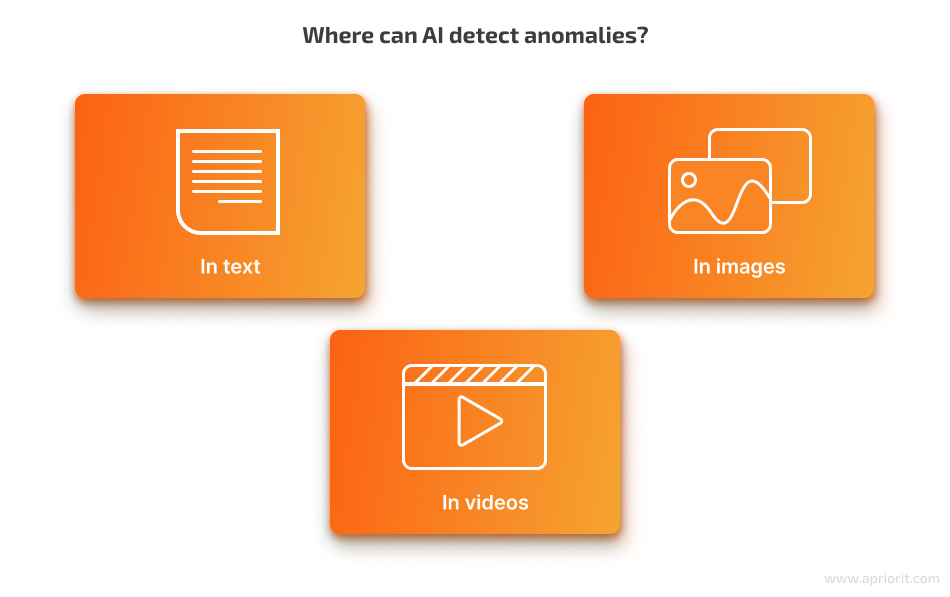
Text analysis. The majority of posts on popular social media channels, except for video-centric platforms like TikTok and YouTube, are text-based. Analyzing them with AI provides you with much more information than a simple keyword search. AI can determine an author’s sentiment, interpret metaphors, and decipher internet slang and coded messages. It can even understand humor and detect false statements. These AI capabilities help anomaly detection software flag anomalies and conduct thorough analysis.
Image analysis. AI-based image analysis helps to recognize image contents: text, objects, and the overall context. Reading text from images allows for processing posts with text overlays, which are popular on platforms such as Facebook. After an image processing algorithm singles out text from the image, an AI text analysis algorithm can work with it like with an ordinary textual record.
When it comes to pictures, screenshots, and other images, you can use various image processing algorithms to recognize objects, segment and classify images, search for patterns, and so on. You can also fix image distortions with AI to improve analysis results.
Video analysis. When analyzed carefully, videos posted on social media can be a great source of security-related information. AI algorithms can detect objects, actions, people, and even recognize emotions, as well as classify different videos. They can help to detect violence, search for missing persons, and provide security overviews at mass events.
Note that building an AI solution for video analysis is a more challenging but achievable task compared to building a solution for analyzing text and images. It requires collecting diverse databases, conducting extensive algorithm training, and using a lot of hardware power to process videos.
Now let’s take a look at tasks for AI algorithms that are useful for anomaly detection on social networks. Keep in mind that the SaaS part of a solution can perform all non-intelligent tasks like web crawling and storing data.
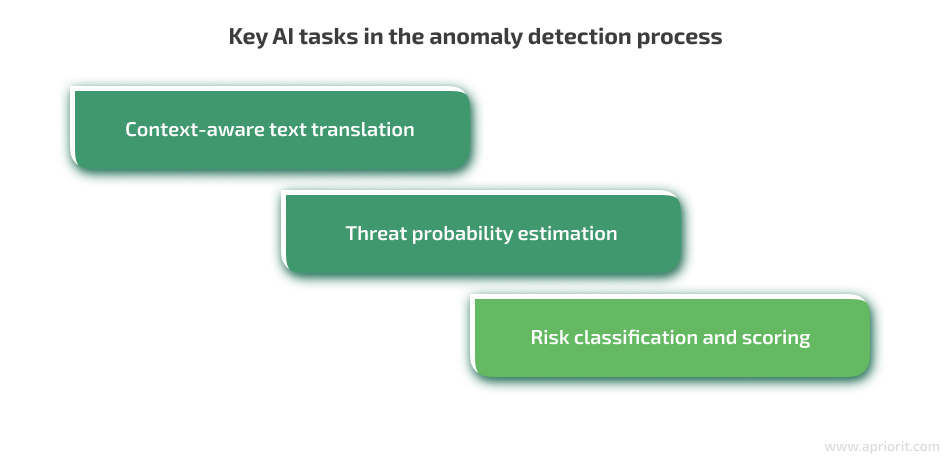
Сontext-aware text translation. For international organizations, it can be important to detect unusual posts on social media all over the world. This task calls for a translation module in anomaly detection software. Using a non-AI translator will reduce the efficiency of your software, as such translators aren’t good at handling context, metaphors and references, grammatical errors, and typos.
Instead, you can add an API from the DeepL Python library, ChatGPT from OpenAI, Translation AI from Google Cloud, or any other translation service. When choosing one, take into account the technologies your software uses, the expertise of your development team, the capabilities of the AI service, and the cost of translation.
Threat probability estimation. Not all unusual posts on social media have to be flagged as suspicious. For example, a heated argument online can result in nothing or in real-world harassment. AI can estimate the probability that a threat is real. To do this, an algorithm can assess whether the author is a human or a bot, analyze the author’s previous posts, and determine the sentiment of the suspicious post.
The results of threat estimation will help specialists that review social media anomalies make decisions and react faster to anomalies that justify a response. For this task, you can use ready AI models for time series analysis and natural language processing. You can also leverage Python libraries like spaCY, NLTK, scikit-learn, and Gensim.
Risk classification and scoring. Apart from evaluating threats, AI and ML algorithms can assess the importance, or severity, of a discovered anomaly, and can assign a risk score to it. Risk scoring helps specialists that work with an anomaly detection system interpret and respond to findings early and fast.
Since risk assessment is a common use case for AI and ML, there are a lot of available risk classification AI algorithms [PDF] for various tasks, industries, and specific cases. You can find an algorithm that more or less fits your project instead of developing one from scratch. However, keep in mind that you’ll need to train this algorithm with your dataset and adjust it to your specific task.
Despite its vast capabilities, AI-powered anomaly detection still heavily relies on specialists that work with the system. AI can only prepare information about an anomaly for a human’s review, thus saving specialists time and effort. But it can’t make a final decision about threat probability and choose the best way to handle an anomaly.
The efficiency of an anomaly detection solution also heavily depends on how well it is implemented. Let’s take a look at the key challenges you can face when working on anomaly detection and how to overcome them.
Read also
Third-Party Integrations with Python: Capabilities and Tools
Expand your software capabilities! Discover how Python’s extensive libraries and frameworks simplify third-party integrations, ensuring efficient and secure connections.

What are the challenges of building a SaaS-based anomaly detection solution?
Delivering such a complex solution requires expertise in cloud app development, AI development, and even compliance law. Here are the key challenges your team may encounter when working on a social media anomaly detection SaaS solution:
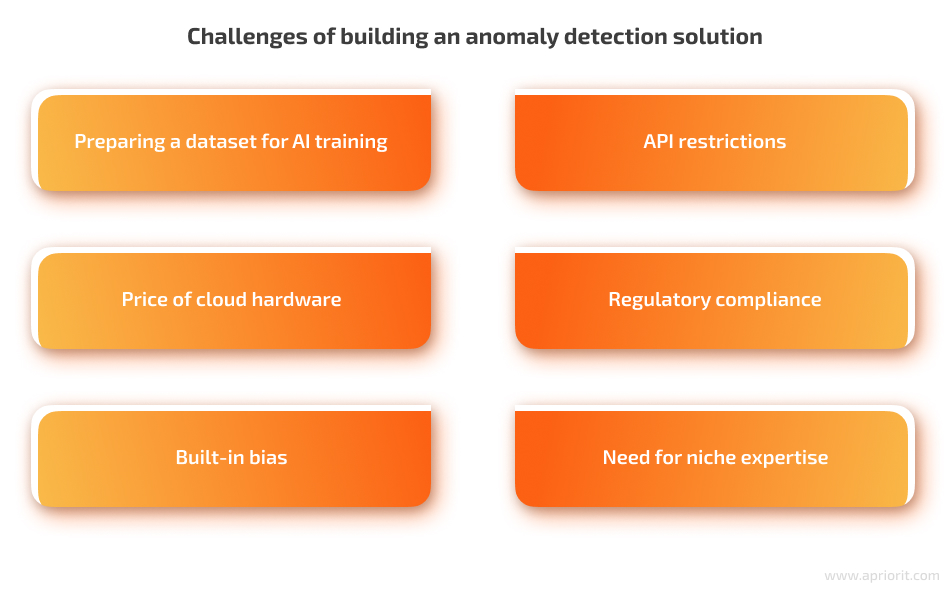
Datasets for AI training. Any AI algorithm requires training on a relevant dataset before it can be applied in real-world scenarios. Preparing a dataset for anomaly detection includes several challenges. Anomaly detection algorithms must rely on data that is accurate, consistent, valid, and balanced for effective anomaly detection. Data has to be labeled based on the types of anomalies the algorithm should detect. The dataset also has to define what constitutes normal and abnormal data.
It’s almost impossible to find a ready dataset that fits a specific purpose, which is why development teams often create datasets manually. This process can be time-consuming and requires both development and domain expertise. Also, keep in mind that your solution may require additional training after the release to improve the accuracy of its results or teach it to detect new threats.
API restrictions. Including third-party components and their APIs in an anomaly detection solution is a great way to reduce the development time and cost. However, it creates a set of limitations for your solution. For example, API restrictions can limit the amount and type of data that can be accessed, which can hinder the accuracy and effectiveness of the anomaly detection solution. APIs also may have rate limits that restrict the frequency and volume of requests. Also, any update on the API’s side can break integrated functionality or introduce security risks.
It’s impossible to completely predict and overcome API-related challenges, but you can prepare for them by thoroughly researching third-party products before you integrate them.
Price of cloud hardware. AI algorithms can take a lot of computing power to process information. Hosting an anomaly detection solution on a cloud service allows you to avoid hardware bottlenecks, scaling issues, and possible hardware shortages caused by the AI development boom. However, the cost of renting cloud resources can rise fast if you don’t tune your algorithms.
To control cloud costs, clearly define which social media content you want to monitor and how much information you want your software to process. Make sure that AI performs only the tasks that require intelligent algorithms and that all other tasks are done by non-AI tools that are less resource-hungry.
Regulatory compliance. An anomaly detection solution that monitors social media needs to store information about detected anomalies and analysis results. Protecting this information in accordance with legal requirements allows you to both ensure data security and avoid issues with non-compliance.
The challenge here is the lack of regulations on using AI for anomaly detection. While there are no practices specifically for such solutions, you can rely on international regulations like the GDPR and your local data protection laws and standards.
Built-in bias. An AI solution can’t be completely prejudice-free and fair because it inherits biases from the development team that created it. That team chooses algorithms, development tools, and data for training based on their experience, mindset, and social and professional background. AI bias creates both ethical and quality challenges for anomaly detection.
While it’s impossible to eradicate biases completely, you can reduce the risk of introducing them into your AI model by:
- increasing the transparency of the development process
- collecting a diverse training dataset
- testing your solution extensively
- gathering a diverse project team
Need for niche expertise. Delivering a complex AI solution requires you to gather specialists with very different expertise: AI and ML development, SaaS development, cloud infrastructure management, cybersecurity, professional experience in the target industry. Gathering such a diverse team is a challenge for any company. And retaining a team of experts will also result in an increased budget.
To mitigate this challenge, you can look for outsourcing companies like Apriorit that already have the expertise you need to deliver your project. We have finished multiple AI and cloud development projects for clients from many industries. This experience helps us adjust to each client’s needs and propose the most convenient method of work.
Conclusion
Monitoring social media and detecting unusual posts can help you achieve various tasks: prevent security threats, fight terrorism, find new trends and topics, and more. Using AI for anomaly detection helps specialists save time on manual work and conduct higher-quality anomaly analysis. And deploying such a solution in the cloud allows for reducing maintenance costs and increasing accuracy compared to manual anomaly detection.
Developing an anomaly detection solution requires a team with diverse development expertise. At Apriorit, we have expert teams of Python developers that have successfully delivered many AI and SaaS projects and can create an anomaly detection solution that fits your business needs.
Let’s enhance your software with text anomaly detection!
Team up with Apriorit’s dedicated AI development teams to create cutting-edge solutions and integrate them in your system.



